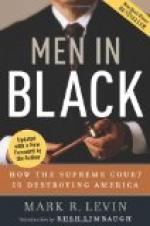The extent to which the examination of the fitness of jurors may go is in the discretion of the court. The two extremes are represented by the methods in the English courts where the judge exercises close supervision over every question in the selection of the jury in what would be considered in America an arbitrary and unjustifiable manner, and the extreme liberality at criminal trials in this country. The difference in time is often between that of a few minutes and a few weeks.
Naturally the challenge for cause may or may not be allowed by the judge—the form being, “Your Honor, I ask you to excuse Mr. Smith,”—because the lawyers are more careful in attempting them; for if they are not allowed the juror challenged may be small-minded enough to retain a grudge against the counsel. The sure challenges are the peremptory ones without any cause stated or reason given. The number of peremptory challenges for each side is usually six. As soon as a juror is challenged he steps out of the box and the clerk draws a new name from the wheel.
It is very much as if a player were dealt a hand of twelve cards, and under the rules of the game each side can discard and draw six times from the pack six single cards to improve his holding. The hand, however, is not only his but his opponent’s, who may likewise discard and draw six cards when the first player is satisfied. When the second player is through the first may again discard any of the new cards the second has substituted, provided, of course, that six drawings have not been exhausted. This game of chance is always played with an eye to creating a favorable impression on the jury and may be politely finessed to the extreme.
“Mr. Merriweather, do you know the defendant in this case, Mr. Jacobs, or his attorney, Mr. Jenkins, or his assistant, Mr.—er—the young gentleman on his left?” is the usual form, delivered with the utmost urbanity. It means very little, but perhaps helps the lawyer to identify an antagonistic juryman and to obtain their answers, which are almost uniformly in the negative. It is obviously desirable that the juryman, as a judge, should not be a friend of the opposite side. From the manner of the man in the box, as he answers, may possibly be inferred his general disposition, and all further questions have this purpose in view. So the attorney for the plaintiff proceeds throughout the twelve before him, and he may say at any time, “Your Honor, I excuse juror number so and so.”
Usually he examines the whole twelve before “excusing” any of them, and when doing so many lawyers turn from the box to the judge as they say, “I will excuse numbers four, five, and eleven.” Frequently those remaining do not realize why their brethren have been dismissed. A slight bewilderment may pass across the faces of all, as a man here and there, under the beckoning finger of the clerk, rises to give up his seat.
Opinion differs as to the extent to which challenges should be exercised. Some trial lawyers are chary in using them, being anxious to appear frank, trusting and willing to accept the judgment of any decent citizen. Others are meticulously insistent and exhaust all their challenges. The first attitude is the one of saying:




